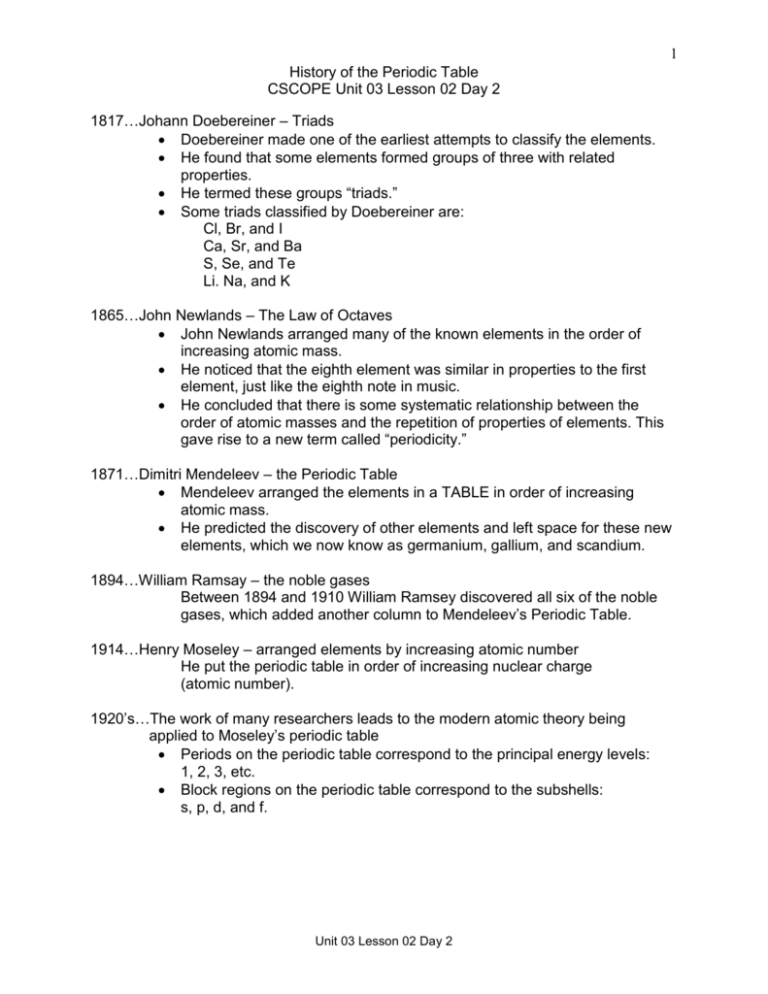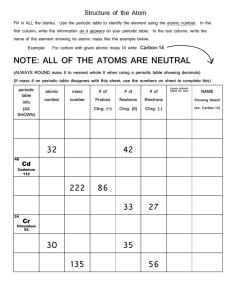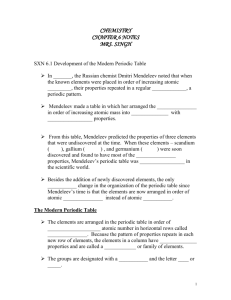Day 2 – History of the Periodic Table
advertisement

1 History of the Periodic Table CSCOPE Unit 03 Lesson 02 Day 2 1817…Johann Doebereiner – Triads Doebereiner made one of the earliest attempts to classify the elements. He found that some elements formed groups of three with related properties. He termed these groups “triads.” Some triads classified by Doebereiner are: Cl, Br, and I Ca, Sr, and Ba S, Se, and Te Li. Na, and K 1865…John Newlands – The Law of Octaves John Newlands arranged many of the known elements in the order of increasing atomic mass. He noticed that the eighth element was similar in properties to the first element, just like the eighth note in music. He concluded that there is some systematic relationship between the order of atomic masses and the repetition of properties of elements. This gave rise to a new term called “periodicity.” 1871…Dimitri Mendeleev – the Periodic Table Mendeleev arranged the elements in a TABLE in order of increasing atomic mass. He predicted the discovery of other elements and left space for these new elements, which we now know as germanium, gallium, and scandium. 1894…William Ramsay – the noble gases Between 1894 and 1910 William Ramsey discovered all six of the noble gases, which added another column to Mendeleev’s Periodic Table. 1914…Henry Moseley – arranged elements by increasing atomic number He put the periodic table in order of increasing nuclear charge (atomic number). 1920’s…The work of many researchers leads to the modern atomic theory being applied to Moseley’s periodic table Periods on the periodic table correspond to the principal energy levels: 1, 2, 3, etc. Block regions on the periodic table correspond to the subshells: s, p, d, and f. Unit 03 Lesson 02 Day 2 2 Unit 03 Lesson 02 Day 2 3 You will be color-coding and labeling a periodic table today applying modern atomic theory to the regions of the periodic table. Number each column from 1 to 18 from left to right. 01. Inside the first box in the “Left Tower” of the blank periodic table, in the first column, write “1s”. 02. Inside the second box down in the first column write “2s”. 03. Continue numbering the boxes in the first column to the bottom box, which will be “7s”. 04. Inside the first box in the “Wall” of the blank periodic table, in the third column, write “3d”. 05. Inside the second box down in the third column write “4d”. 06. Continue numbering the boxes in the third column to the bottom box, which will be “6d”. 07. Inside the first box in the “Right Tower” of the blank periodic table, in the thirteenth column, write “2p”. 08. Inside the second box down in the thirteenth column write “3p”. 09. Continue numbering the boxes in the thirteenth column to the bottom box, which will be “6p”. This is where the pattern breaks. 10. Inside the first box in the eighteenth column write “1s”. Do NOT number any more boxes in that column. Go to the “Moat” of the blank periodic table, the freestanding set of twenty-eight boxes at the bottom of the periodic table. 11. Inside the first box in the first column in the “Moat” write “4f”. 12. Inside the next box down in the first column in the “Moat” write “5f”. Unit 03 Lesson 02 Day 2 4 Now it is time to color the block regions of the periodic table. 13. Use a light-colored GREEN map color to color columns 1 and 2. 14. Use a light-colored BLUE map color to color columns 3 through 12. 15. Use a light-colored GREEN map color to color ONLY the FIRST box in column 18. 16. Use a light-colored YELLOW map color to color columns 13 through the rest of column 18. 17. Use a light-colored PINK map color to color the “Moat” of the blank periodic table, the freestanding set of twenty-eight boxes at the bottom of the periodic table. 18. Provide a key on our blank periodic table for your color-coding on your periodic table, so that others can interpret it: GREEN is “s”. YELLOW is “p”. BLUE is “d”. PINK is “f”. 01. How were Newlands’ “octaves” like Doebereiner’s “triads”? 02. What were Mendeleev’s two key contributions to the development of the modern periodic table? 1) 2) 03. What was Ramsay’s key contribution to the development of the modern periodic table? 04. What was Moseley’s key contribution to the development of the modern periodic table? Unit 03 Lesson 02 Day 2





